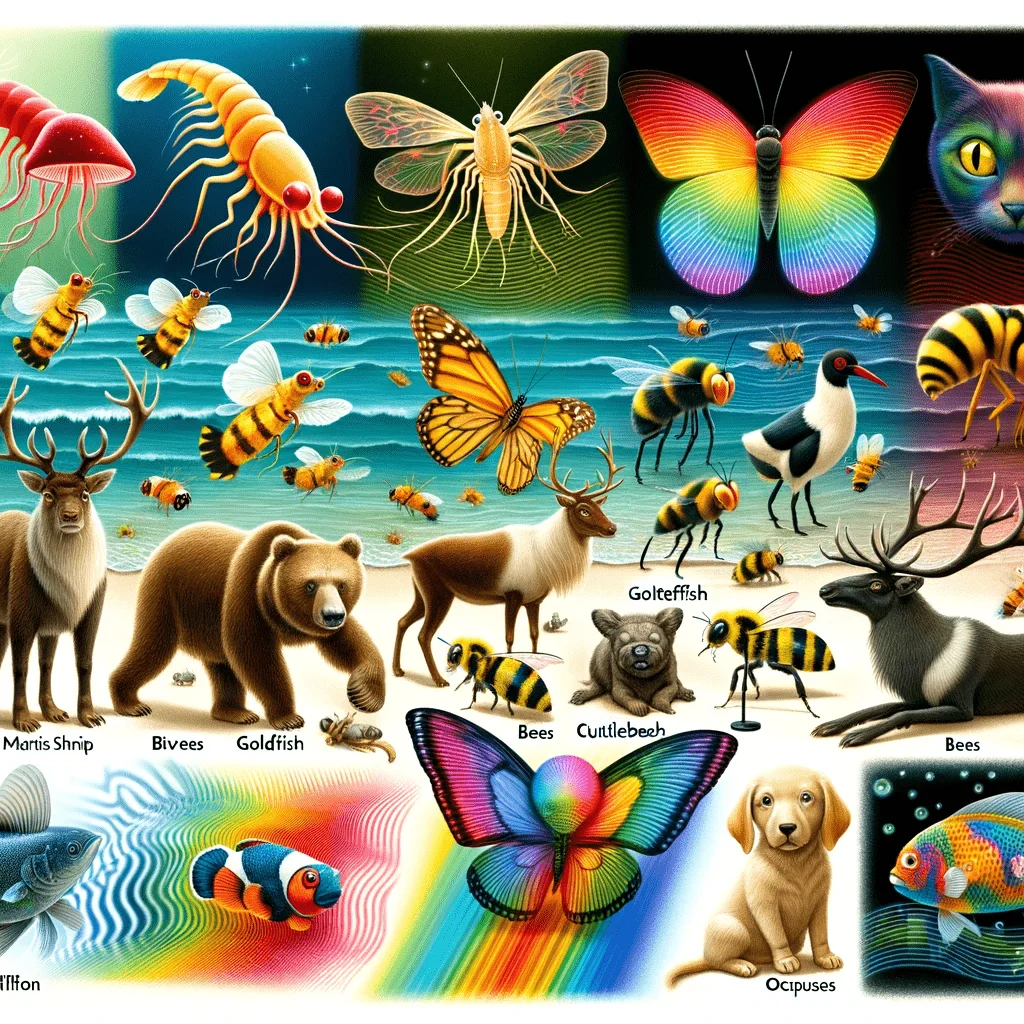Perception of Electromagnetic Spectrum

Human perception is limited by the biophysical constraints of our sensory organs. Our eyes, for instance, can only perceive a fraction of the electromagnetic spectrum, roughly ranging from 400 to 700 nanometers (nm), covering violet to red light. This narrow band of visual experience raises an intriguing question: what are we missing? When it comes to phenomena that exist outside our perceptual range, such as Unidentified Aerial Phenomena (UAP) or potential extraterrestrial entities, the limitations of human perception can be more than just a philosophical curiosity—they can be a scientific blind spot. To explore this, we look into the visual systems of various animals that have evolved unique ways of sensing the world, surpassing human capabilities in specific aspects.
Mantis Shrimp
The mantis shrimp is a marvel of visual complexity. It has compound eyes divided into three regions, allowing for a kind of trinocular vision that grants depth perception. These eyes contain an astonishing 16 types of photoreceptor cells for color vision, compared to the mere three types in humans. The shrimp can perceive wavelengths ranging from deep ultraviolet (around 300 nm) to far-red (around 720 nm), thus covering a broader spectral range than humans. It can also detect circularly polarized light, a feature unique to its kind. All these abilities enable the mantis shrimp to hunt effectively, spot predators, and identify mates in their vibrant underwater ecosystem.
Pit Vipers
Pit vipers are equipped with specialized heat-sensing organs known as “pit organs,” located between their eyes and nostrils. While human eyes are blind to the infrared spectrum, which starts at around 750 nm, pit vipers can perceive wavelengths up to about 30,000 nm. Their pit organs contain thermoreceptor cells that can detect minute variations in temperature, allowing these vipers to construct a thermal map of their surroundings. This gives them a distinctive advantage in locating warm-blooded prey, even in pitch-black conditions.
Goldfish
Goldfish are capable of perceiving both ultraviolet and infrared light, thanks to specialized photoreceptor cells in their retinas. These cells capture a broad range of wavelengths from around 300 nm to 750 nm. The goldfish’s visual system is further diversified by having four types of cone cells for color vision, in contrast to humans’ three. This broad spectral vision facilitates tasks like foraging for food and evading predators, especially in environments with variable lighting conditions.
Bees
Bees possess the capability to see ultraviolet light, a spectrum invisible to humans. Their photoreceptors are sensitive to UV, blue, and green wavelengths, allowing them to discern floral patterns that guide them to nectar. In terms of spectral range, bees can perceive light wavelengths as low as around 300 nm, effectively seeing colors and patterns entirely invisible to human eyes.
Butterflies
Butterflies also have the ability to see ultraviolet light, thanks to photoreceptor cells sensitive to wavelengths starting from approximately 310 nm. Moreover, they can possess up to six types of photopigments, granting them a spectrum of color vision far richer than the trichromatic vision of humans. Some butterfly species even have ultraviolet patterns on their wings, crucial for mating and other social interactions.
Cuttlefish
Cuttlefish can see polarized light, an ability rare among animals and absent in humans. Although their spectral range hasn’t been as definitively measured as in some other animals, their eyes, uniquely W-shaped, offer a large field of vision. Their ability to perceive polarized light enables them to see contrasts and outlines more clearly, providing a distinct advantage in hunting and camouflage in their aquatic habitats.
Birds (Certain Species like Pigeons)
Some bird species, including pigeons, extend their vision into the ultraviolet range, detecting wavelengths as low as around 350 nm. In contrast to humans’ three types of cone cells, these birds often possess tetrachromatic vision, with four types of cone cells, enhancing their range and differentiation of colors. This capability can offer assistance in navigation and possibly contribute to more vivid mating displays and social signaling.
Reindeer
Reindeer are equipped to see ultraviolet light, an ability stemming from UV-sensitive photoreceptor cells in their retinas. They can perceive light down to about 320 nm. This capability is particularly useful in Arctic conditions, where the snow and ice reflect a large amount of UV light, helping them detect food, predators, and other reindeer more effectively.
Octopuses
Octopuses have the ability to see polarized light, thanks to specialized photoreceptor cells in their retinas that detect the angle of polarization. While their spectral range isn’t as extensive as some other animals, this polarization detection adds a layer of complexity to their visual perception that humans lack. This enhanced vision aids them in hunting and provides some degree of protection against predators.
Dogs/Cats
Though not as spectrally specialized as other animals on this list, both dogs and cats can perceive certain parts of the ultraviolet spectrum, extending down to about 300 nm. The presence of UV-sensitive cells in their retinas makes this possible. While the exact evolutionary advantage of this ability is not fully understood, it might assist these animals in following scent trails or detecting markings, such as urine, that are visible under ultraviolet light.
The adaptations in visual perception seen across different species provide a humbling perspective on the limitations of human sensory abilities. While we navigate our world through a particular set of sensory filters, other organisms interact with dimensions of light and color beyond our comprehension. Their evolved capacities enable them to thrive in their specific environments, whether it’s the mantis shrimp’s unparalleled color vision aiding in underwater hunting or the pit viper’s thermal imaging capability that helps locate prey in the dark. As we ponder phenomena that we struggle to explain or even detect, such as UAP or potential extraterrestrial life forms, it’s imperative to consider that our perceptual limitations may constrain our understanding and interpretation of such phenomena. Consequently, advancing our scientific inquiries may require tools and techniques that compensate for or extend our natural sensory limitations.


